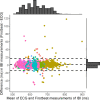An external telemetry system for recording resting heart rate variability and heart rate in free-ranging large wild mammals
- PMID: 34086713
- PMCID: PMC8177659
- DOI: 10.1371/journal.pone.0252013
An external telemetry system for recording resting heart rate variability and heart rate in free-ranging large wild mammals
Abstract
Measures of heart rate variability (and heart rate more generally) are providing powerful insights into the physiological drivers of behaviour. Resting heart rate variability (HRV) can be used as an indicator of individual differences in temperament and reactivity to physical and psychological stress. There is increasing interest in deriving such measures from free ranging wild animals, where individuals are exposed to the natural and anthropogenic stressors of life. We describe a robust, externally mounted heart rate monitor for use in wild mammals, deployed here on wild breeding adult female grey seals (Halichoerus grypus), that delivers millisecond precise measures of inter beat intervals (IBIs), allowing computation of resting HRV parameters. Based on Firstbeat™ heart rate belts, our system allows for remote, continuous recording of IBI data from over 30 individuals simultaneously at ranges of up to 200m. We assessed the accuracy of the IBI data provided by the Firstbeat™ system using concurrent IBI data derived from in-field electrocardiogram (ECG) recordings. Bland-Altmann analyses demonstrated high correspondence between the two sets of IBI data, with a mean difference of 0.87±0.16ms. We used generalized additive mixed-effects models to examine the impact of the default Firstbeat™ software artefact correction procedure upon the generation of anomalous data (flats and stairs). Artefact correction and individual activity were major causes of flats and stairs. We used simulations and models to assess the impact of these errors on estimates of resting HRV and to inform criteria for subsampling relatively error free IBI traces. These analyses allowed us to establish stringent filtering procedures to remove traces with excessive numbers of artefacts, including flats and stairs. Even with strict criteria for removing potentially erroneous data, the abundance of data yielded by the Firstbeat™ system provides the potential to extract robust estimates of resting HRV. We discuss the advantages and limitations of our system for applications beyond the study system described here.
Conflict of interest statement
The authors have declared that no competing interests exist.
Figures








References
-
- von Borell E, Langbein J, Despres G, Hansen S, Leterrier C, Marchant-Forde J, et al.. Heart rate variability as a measure of autonomic regulation of cardiac activity for assessing stress and welfare in farm animals: a review. Physiol. Behav. 2007. 92:293–316. doi: 10.1016/j.physbeh.2007.01.007 - DOI - PubMed
-
- Marchant-Forde RM, Marlin DJ, Marchant-Forde JN. Validation of a cardiac monitor for measuring heart rate variability in adult female pigs: accuracy, artefacts and editing. Physiol. Behav. 2004. 80:449–458. - PubMed
Publication types
MeSH terms
LinkOut - more resources
Full Text Sources

